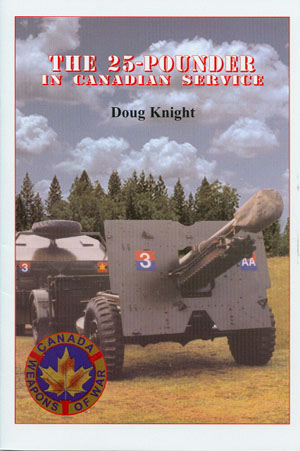'Weapons of War' Series: The 25-Pounder
in Canadian Service
by Doug Knight

Service Publications, Ottawa, Ontario, Canada, 2005; 24 pp. with B&W
photos; price CDN $9.95; ISBN 1-894581-26-1 (http://www.servicepub.com)
Advantages: Good, clearcut description of both the 25-lb gun and its
operation as well as how artillery functions; covers all basic Canadian
and most Commonwealth applications as well
Disadvantages: modelers may regret not having more detail information
on regiments and markings
Rating: Highly Recommended
Recommendation: For all Commonwealth fans
If you mention the term "divisional artillery" to anyone from
the Second World War who knows artillery, four guns will immediately be
mentioned: the German leFH 18 10.5 cm howitzer; the US M1/M2 series 105mm
howitzer; the Soviet 76.2mm ZIS-3 gun; and the British 25-pound Field
Gun. All four were by far and away the most used weapons of their type
by their respective nations, and provided most of the "on-call"
artillery fire support for their troops.
The British 25 pounder (so-named for its nominal weight of shell) was
a linear outgrowth of the pre-WWI 13-pounder and its much-improved 18-pounder
replacement. In point of fact, as Doug points out, the 25-pounder began
as a new barrel created from older 18-pounders by boring them out and
using "auto-frettage" – prestressing the barrels from
the inside out to make them lighter and stronger – to tolerate the
larger shells and greater propellant charges. These guns first went into
service in 1936, and eventually received a new carriage and cradle assembly.
The standard version, the Ordnance QF 25-lb Mark II on Mark I carriage,
was the standard field gun for Commonwealth forces during WWII and long
afterwards, until NATO called for standardization on 105mm and 155mm as
divisional calibers in the mid 1950s. Like all things from the Commonwealth,
Canada again stepped to the plate to produce its share of guns, and using
a new ordnance factory built at Sorel, Quebec, just prior to WWII with
the help of the French Scheinder company, the 25-lb gun went into production
in 1940, with the first guns delivered in July 1941.
Doug covers the entire production history of the weapon as well as a
great deal of other information, including regimental organization and
function, crew organization and function, and some items on both the well-known
No. 27 limber (a leftover from horsedrawn days according to all who used
it) and the FAT – field artillery tractor. Produced by both Ford
and GM of Canada, these well-known vehicles with either the flat windshield
No. 12 cab or more popularly known No. 13 cab with reverse slant windshield
were probably better known and more prolific than the Morris tractor that
inspired them.
He points out how anachronistic much of the artillery thinking was involving
this weapon, as the crews hated the limber. (Point: try backing up with
a trailer towing a trailer and that you can't see either one, and you
start to get the idea of why this hatred came about.) Also someone noted
when the crews deployed for action one man stood alone at the rear of
the piece with no apparent function. Someone finally figured out that
he was the "horseholder" from the old days and nobody thought
to eliminate him from the crew!
The 25-lb gun was not the most powerful or longest ranged weapon on
the battlefield, but Doug points out where its strengths were and why
it was popular. One point he makes is the gun fired a projectile only
slightly smaller than the US 105mm (25 pounds versus 33 pounds) to the
same range and with a smaller and more easily handled gun. The 25-lb barrel
was also more long-lived. Artillery weapons' life expectancies are based
on how many "full charge" (e.g. tabular charges for reaching
maximum range as designed without any modifications to the charge or projectile)
rounds could be fired: for the 25-lb gun, it was 10,000 effective full
charge (EFC) rounds. To put this in perspective, Soviet sources note that
their powerful long range 2S5 152mm gun only had a life expectancy of
300 EFC rounds, and that the early T-72 125mm 2A46 gun had a life expectancy
of only 200 EFC (e.g. sabot) rounds. Of course, firing reduced charges
increases life expectancy and "super-charges" reduce it (e.g.
each "super-charge" is rated at 4 EFC for life expectancy computations
for the 25-lb gun). He notes that some guns were still fitted with their
original barrels when placed out of service in the 1950s.
Overall this is a very handy little book, as it also explains a great
deal of artillery operations and functioning. I only noted one minor error
– in the description of the weapon on page 24 the length of the
gun is given as 25 feet 10 3/4 inches; it's not, as that is the complete
length of the gun, No. 27 limber and FAT in march order from tip of the
front towing pintel to the end of the muzzle brake on the later production
guns. (The Canadian vehicles can be modeled in 1/35 scale using the Tamiya
25-lb gun and limber and the older Peerless Max/Italeri/Zvezda FAT with
No. 13 cab, or in resin using various manufacturers in 1/76 scale.)
Thanks to Service Publications for the review copy.
Cookie Sewell
|